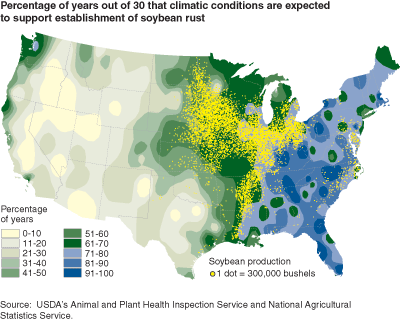Economic Risks of Soybean Rust in the U.S. Vary by Region
- by Stan Daberkow
- 9/1/2004
Soybean rust is a plant disease that has reduced yields and raised production costs for soybeans and other legumes in every major production region of the world—except the United States. However, with the recent and rapid spread of the windborne pathogen in South America, most experts agree that the question isn’t if, but when, it will enter the U.S. via natural spread. An outbreak could pose economic risks for producers and consumers, and affect agricultural and environmental programs, such as crop insurance, commodity programs, research and extension, and pesticide regulations.
An ERS study shows that the economic effects of the pathogen’s entry into the U.S. could vary considerably, depending on the timing, location, spread, and severity of the disease and on the responses of soybean and other crop producers, livestock producers, and consumers. Economic losses to U.S. producers and consumers could range from $640 million to $1.3 billion in the first year of infestation. In the 3-5 years following establishment, losses could average between $240 million and $2.4 billion per year, depending on the geographical extent and severity of annual outbreaks. The wide range in estimates reflects the uncertainty associated with the effects of the disease in the United States. But even the high-end estimates are less than 1 percent of the total economic activity associated with U.S. soybean production and consumption—a finding that confirms the resiliency and adaptability of U.S. agriculture.
Soybean producers would likely bear 60-70 percent of the costs of adjusting to periodic soybean rust outbreaks in the U.S., with consumers and livestock producers bearing the balance. The outbreaks would likely cause agricultural producers, especially soybean growers, to change production practices (for example, to use fungicides and, for some, to alter their crop mix). While producers would have limited management options during the first year of a rust outbreak, these options could increase over time as producers gain new information or as new pest management technologies become available.
The effects of the disease could vary considerably by region. For example, the Eastern U.S. may be more susceptible than other regions to rust infestation because of temperature, relative humidity, and rainfall during the growing season. Fortunately, most U.S. soybean production occurs in the middle part of the country where climate is less supportive of infestation.
This article is drawn from:
- Livingston, M., Johansson, R., Daberkow, S., Roberts, M., Ash, M. & Breneman, V. (2004). Economic and Policy Implications of Wind-Borne Entry of Asian Soybean Rust into the United States. U.S. Department of Agriculture, Economic Research Service. OCS-04D02.


